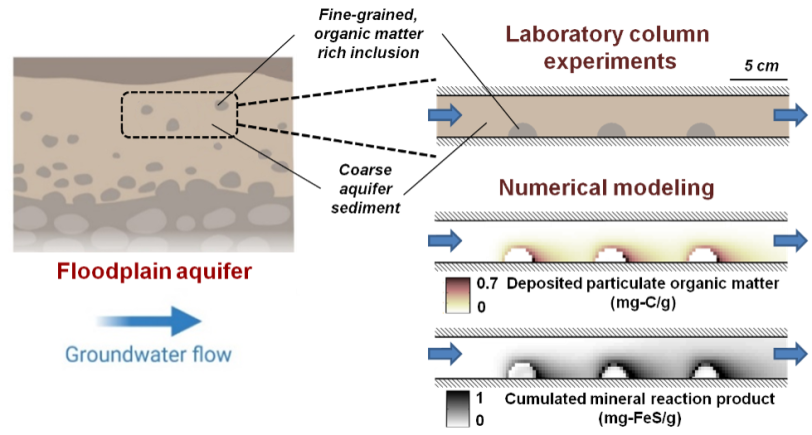Groundwater Quality: Microbial "Halos" Spread through Floodplain Aquifers
By

The Science
Floodplain groundwater is a critical resource for human activities and ecosystems. It is however increasingly threatened by climate change. While the impact of climate change on groundwater quantity is well documented, its impact on groundwater quality has received far less attention. In this study, researchers showed that changes in the flow rate or in the chemical composition of groundwater can destabilize sediments rich in organic matter and microorganisms. The re-deposition of these sediments creates zones, or "halos", of intense microbial activity that further amplify the changes in groundwater composition.
The Impact
The availability of groundwater to humans and ecosystems depends on both its quantity and its quality. This study documents a cascading environmental mechanism, in which a change in the circulation of floodplain groundwater causes a change in its chemical composition. It provides a model that can be used as a stepping stone to better predict the impact of climate change on the groundwater resource.
Summary
The researchers combined laboratory experiments and numerical simulations to investigate how mixing and reaction zones develop in floodplain aquifers. They built a series of 30 cm-long, flow-through column experiments. The columns contained lenses of fine-grained, organic matter rich sediments embedded inside coarser-grained, organic matter poor aquifer sand. Both types of sediments were collected from the same floodplain in Wyoming. Their arrangement inside the columns was mimicking natural sedimentary deposition patterns. Artificial groundwater rich in oxygen was continuously injected at the inlet of the columns.
Results showed that the fine-grained lenses released large amounts of particulate organic matter, likely including live microorganisms, that were transported then re-deposited in the surrounding aquifer material. These transfers of organic matter sustained the development of secondary zones, or "halos", of microbial activity. The cumulative microbial activity in these halos could exceed the activity inside the lenses by several orders of magnitude, owing to their larger volume as well as their access to fresh pools of reactants. The impact of these halos on groundwater quality was both immediate (e.g., decrease in oxygen concentration, increase in iron concentration) and long term, with the accumulation of an inventory of mineral reaction products that could be easily remobilized by subsequent environmental changes.
Principal investigator
Kristin Boye
SLAC
kboye@slac.stanford.edu
ESS Research Area
Watershed Science
ESS Program Manager(s)
Jennifer Arrigo, Paul Bayer
Type of Project
Science Focus Area (SFA)
Scientific User Facility and/or Community Resources Involved
IDEAS-Watershed Project
Funding
The project was conceived and supported by the SLAC Floodplain Hydro-Biogeochemistry SFA program of the US Department of Energy, Office of Biological and Environmental Research, Earth and Environmental Systems Sciences Division.
Publications
Babey, T. et al. Simulation of anoxic lenses as exporters of reactivity in alluvial aquifer sediments. Geochimica et Cosmochimica Acta 334, 119-134,
DOI: https://doi.org/10.1016/j.gca.2022.07.018.
Submitter Contact Information
Tristan Babey
SLAC / Stanford University
tbabey@stanford.edu
